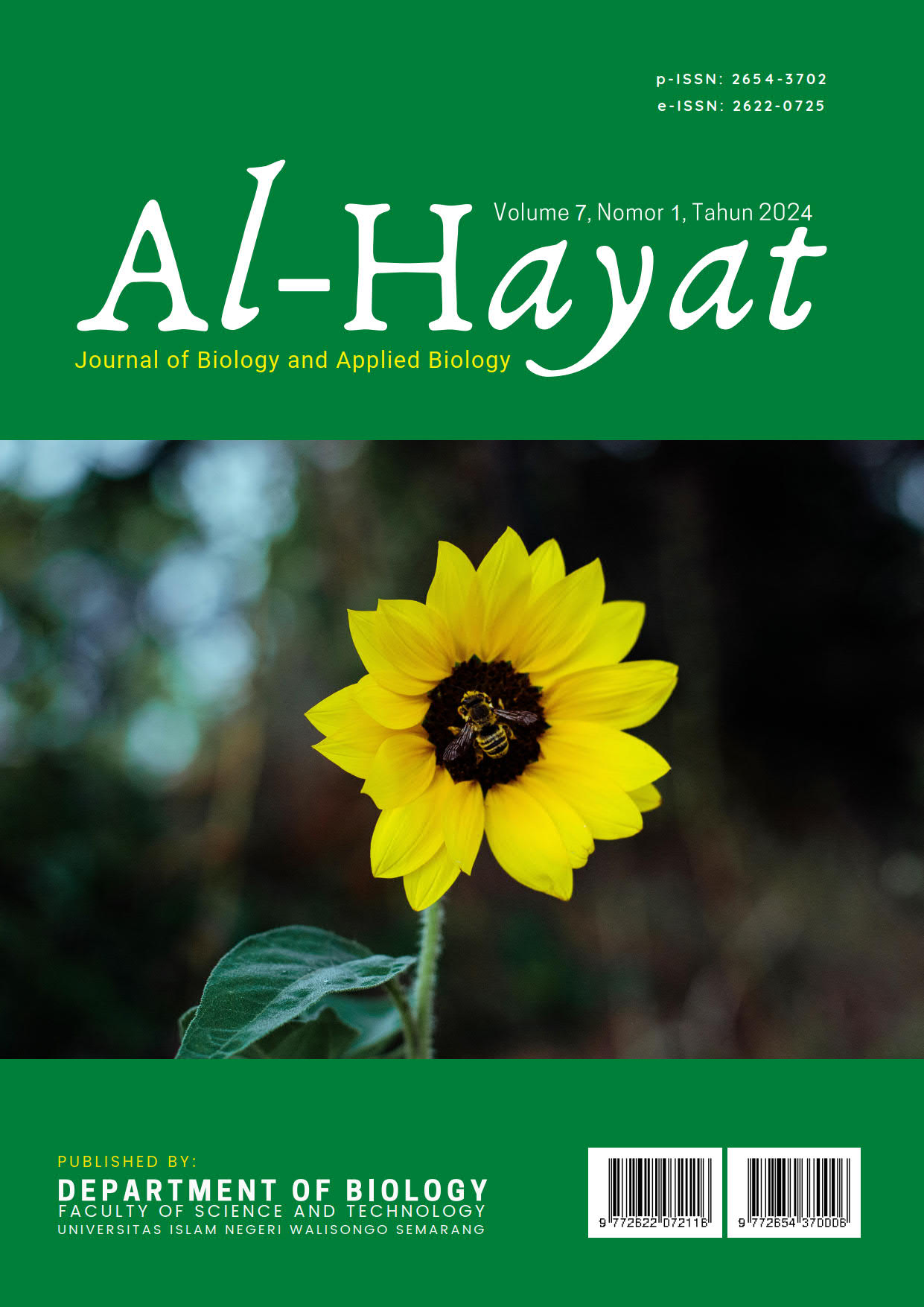Optimizing Gram-Negative Bacteria Isolation from Children Diarrheal Stool Samples in Jakarta: A Comparative Analysis of Six Culture Media
Main Article Content
Abstract
The prevalence of diarrheal illnesses in Indonesia remains a significant concern among children under the age of five, evident through diagnostic findings and symptomatic manifestations, leading to increased rates of mortality and morbidity. This study aimed to identify, isolate, and culture gram-negative bacteria responsible for childhood diarrhea. Twenty stool samples were collected from children under the age of 5 with acute diarrhea in Jakarta health centres and hospitals between October 2023 to January 2024. These samples were inoculated onto selective agars to facilitate the growth of gram-negative bacteria. After a 24-hour incubation period, colonies suspected to be E. coli, K. pneumoniae, Salmonella, Shigella, or Vibrio were identified using the Vitek-2 compact system. The results revealed a notable presence of Gram-negative bacteria in all the fecal samples from diarrheal children, with Escherichia coli (E. Coli) and Klebsiella pneumoniae (Klebsiella p) as the predominant species. In conclusion, our study, utilizing various cultures and the Vitek-2 compact system, elucidates the microbial landscape driving diarrheal morbidity in Indonesian children under five, with E. Coli and klebsiella pneumoniae emerging as prevalent contributors to childhood diarrhea in this population.
Downloads
Article Details
The copyright of the received article shall be assigned to the journal as the publisher of the journal. The intended copyright includes the right to publish the article in various forms (including reprints). The journal maintains the publishing rights to the published articles. Authors are allowed to use their articles for any legal purposes deemed necessary without written permission from the journal with an acknowledgment of initial publication to this journal.
The work under license Creative Commons Attribution-ShareAlike 4.0 International License.
References
Arifin, H., Rakhmawati, W., Kurniawati, Y., Pradipta, R. O., Efendi, F., Gusmaniarti, G., Pramukti, I., Acob, J. R. U., Soares, A., Myint, N. M. M., Setyowati, S., Rosnani, R., Mediarti, D., & Chou, K.-R. (2022). Prevalence and determinants of diarrhea among under-five children in five Southeast Asian countries: Evidence from the demographic health survey. Journal of Pediatric Nursing, 66, e37–e45. https://doi.org/10.1016/j.pedn.2022.06.005
Bitew, B. D., Woldu, W., & Gizaw, Z. (2017). Childhood diarrheal morbidity and sanitation predictors in a nomadic community. Italian Journal of Pediatrics, 43(1), 91. https://doi.org/10.1186/s13052-017-0412-6
Hartman, R. M., Cohen, A. L., Antoni, S., Mwenda, J., Weldegebriel, G., Biey, J., Shaba, K., de Oliveira, L., Rey, G., Ortiz, C., Tereza, M., Fahmy, K., Ghoniem, A., Ashmony, H., Videbaek, D., Singh, S., Tondo, E., Sharifuzzaman, M., Liyanage, J., … Nakamura, T. (2023). Risk Factors for Mortality Among Children Younger Than Age 5 Years With Severe Diarrhea in Low- and Middle-income Countries: Findings From the World Health Organization-coordinated Global Rotavirus and Pediatric Diarrhea Surveillance Networks. Clinical Infectious Diseases, 76(3), e1047–e1053. https://doi.org/10.1093/cid/ciac561
Kotloff, K. L. (2017). The Burden and Etiology of Diarrheal Illness in Developing Countries. Pediatric Clinics of North America, 64(4), 799–814. https://doi.org/10.1016/j.pcl.2017.03.006
Mardu, F., Negash, H., Legese, H., Berhe, B., Tesfay, K., Haileslasie, H., Tesfanchal, B., Gebremichail, G., Belay, G., & Gebremedhin, H. (2020). Assessment of knowledge, practice, and status of food handlers toward Salmonella, Shigella, and intestinal parasites: A cross-sectional study in Tigrai prison centers, Ethiopia. PLOS ONE, 15(11), e0241145. https://doi.org/10.1371/journal.pone.0241145
Muziburrahman, M.-, Husada, D., & Utomo, B. (2022). Identification Of Bacteria Causing Diarrhea in Under-Fives Children Using Culture Methods In Bima, Indonesia. Jurnal Berkala Epidemiologi, 10(1), 95. https://doi.org/10.20473/jbe.v10i12022.95-102
Nemeth, V., & Pfleghaar, N. (2024). Diarrhea.
Oyofo, B. A., Lesmana, M., Subekti, D., Tjaniadi, P., Larasati, W., Putri, M., Simanjuntak, C. H., Punjabi, N. H., Santoso, W., Muzahar, Sukarma, Sriwati, Sarumpaet, S., Abdi, M., Tjindi, R., Ma’ani, H., Sumardiati, A., Handayani, H., Campbell, J. R., … Corwin, A. L. (2002). Surveillance of bacterial pathogens of diarrhea disease in Indonesia. Diagnostic Microbiology and Infectious Disease, 44(3), 227–234. https://doi.org/10.1016/S0732-8893(02)00454-6
Riaz, M. M., Patel, M. J., Khan, M. S., Anwar, M. A., Tariq, M., Hilal, H., Awan, S., & Razi, S. (2012). Clinical characteristics and predictors of positive stool culture in adult patients with acute gastroenteritis. JPMA. The Journal of the Pakistan Medical Association, 62(1), 20–24.
Sparbier, K., Weller, U., Boogen, C., & Kostrzewa, M. (2012). Rapid detection of Salmonella sp. by means of a combination of selective enrichment broth and MALDI-TOF MS. European Journal of Clinical Microbiology & Infectious Diseases, 31(5), 767–773. https://doi.org/10.1007/s10096-011-1373-0
Taylor, W. I., & Schelhart, D. (1971). Isolation of Shigellae. Applied Microbiology, 21(1), 32–37. https://doi.org/10.1128/am.21.1.32-37.1971
Virpari, P. K., Nayak, J. B., Thaker, H. C., & Brahmbhatt, M. N. (2013). Isolation of pathogenic Escherichia coli from stool samples of diarrheal patients with history of raw milk consumption. Veterinary World, 6(9), 659–663. https://doi.org/10.14202/vetworld.2013.659-663
Voetsch, A. C., Angulo, F. J., Rabatsky‐Ehr, T., Shallow, S., Cassidy, M., Thomas, S. M., Swanson, E., Zansky, S. M., Hawkins, M. A., Jones, T. F., Shillam, P. J., Van Gilder, T. J., Wells, J. G., & Griffin, P. M. (2004). Laboratory Practices for Stool‐Specimen Culture for Bacterial Pathogens, Including Escherichia coli O157:H7, in the FoodNet Sites, 1995–2000. Clinical Infectious Diseases, 38(s3), S190–S197. https://doi.org/10.1086/381586

